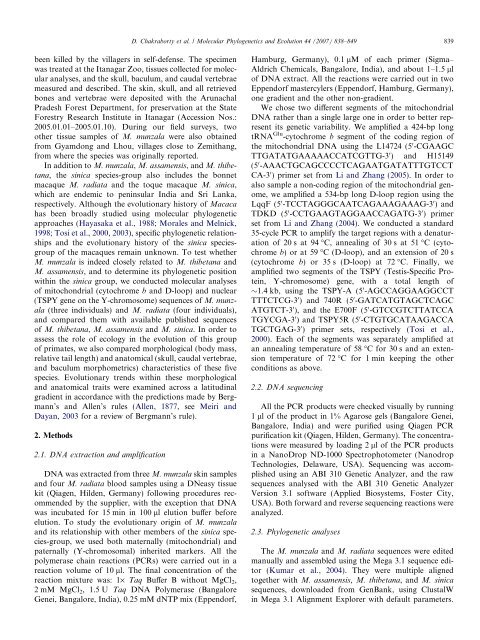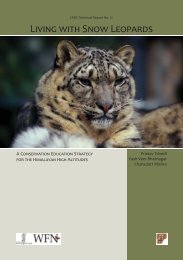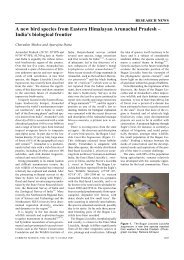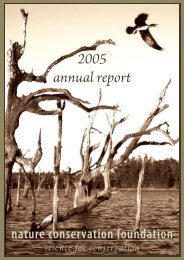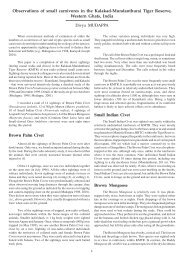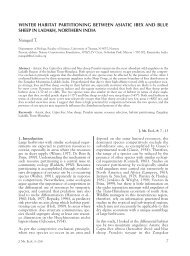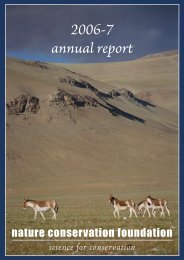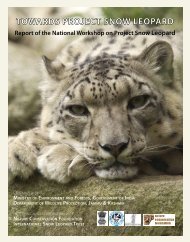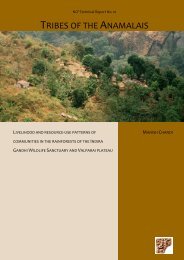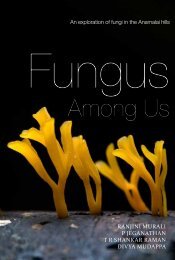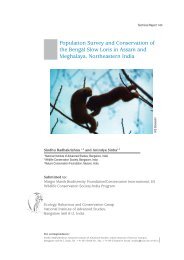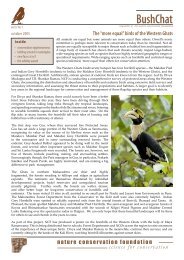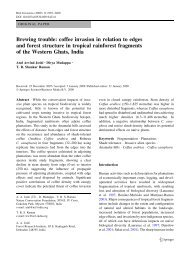Macaca munzala - Nature Conservation Foundation
Macaca munzala - Nature Conservation Foundation
Macaca munzala - Nature Conservation Foundation
Create successful ePaper yourself
Turn your PDF publications into a flip-book with our unique Google optimized e-Paper software.
een killed by the villagers in self-defense. The specimen<br />
was treated at the Itanagar Zoo, tissues collected for molecular<br />
analyses, and the skull, baculum, and caudal vertebrae<br />
measured and described. The skin, skull, and all retrieved<br />
bones and vertebrae were deposited with the Arunachal<br />
Pradesh Forest Department, for preservation at the State<br />
Forestry Research Institute in Itanagar (Accession Nos.:<br />
2005.01.01–2005.01.10). During our field surveys, two<br />
other tissue samples of M. <strong>munzala</strong> were also obtained<br />
from Gyamdong and Lhou, villages close to Zemithang,<br />
from where the species was originally reported.<br />
In addition to M. <strong>munzala</strong>, M. assamensis, and M. thibetana,<br />
the sinica species-group also includes the bonnet<br />
macaque M. radiata and the toque macaque M. sinica,<br />
which are endemic to peninsular India and Sri Lanka,<br />
respectively. Although the evolutionary history of <strong>Macaca</strong><br />
has been broadly studied using molecular phylogenetic<br />
approaches (Hayasaka et al., 1988; Morales and Melnick,<br />
1998; Tosi et al., 2000, 2003), specific phylogenetic relationships<br />
and the evolutionary history of the sinica speciesgroup<br />
of the macaques remain unknown. To test whether<br />
M. <strong>munzala</strong> is indeed closely related to M. thibetana and<br />
M. assamensis, and to determine its phylogenetic position<br />
within the sinica group, we conducted molecular analyses<br />
of mitochondrial (cytochrome b and D-loop) and nuclear<br />
(TSPY gene on the Y-chromosome) sequences of M. <strong>munzala</strong><br />
(three individuals) and M. radiata (four individuals),<br />
and compared them with available published sequences<br />
of M. thibetana, M. assamensis and M. sinica. In order to<br />
assess the role of ecology in the evolution of this group<br />
of primates, we also compared morphological (body mass,<br />
relative tail length) and anatomical (skull, caudal vertebrae,<br />
and baculum morphometrics) characteristics of these five<br />
species. Evolutionary trends within these morphological<br />
and anatomical traits were examined across a latitudinal<br />
gradient in accordance with the predictions made by Bergmann’s<br />
and Allen’s rules (Allen, 1877, see Meiri and<br />
Dayan, 2003 for a review of Bergmann’s rule).<br />
2. Methods<br />
2.1. DNA extraction and amplification<br />
D. Chakraborty et al. / Molecular Phylogenetics and Evolution 44 (2007) 838–849 839<br />
DNA was extracted from three M. <strong>munzala</strong> skin samples<br />
and four M. radiata blood samples using a DNeasy tissue<br />
kit (Qiagen, Hilden, Germany) following procedures recommended<br />
by the supplier, with the exception that DNA<br />
was incubated for 15 min in 100 ll elution buffer before<br />
elution. To study the evolutionary origin of M. <strong>munzala</strong><br />
and its relationship with other members of the sinica species-group,<br />
we used both maternally (mitochondrial) and<br />
paternally (Y-chromosomal) inherited markers. All the<br />
polymerase chain reactions (PCRs) were carried out in a<br />
reaction volume of 10 ll. The final concentration of the<br />
reaction mixture was: 1· Taq Buffer B without MgCl2,<br />
2 mM MgCl 2, 1.5 U Taq DNA Polymerase (Bangalore<br />
Genei, Bangalore, India), 0.25 mM dNTP mix (Eppendorf,<br />
Hamburg, Germany), 0.1 lM of each primer (Sigma–<br />
Aldrich Chemicals, Bangalore, India), and about 1–1.5 ll<br />
of DNA extract. All the reactions were carried out in two<br />
Eppendorf mastercylers (Eppendorf, Hamburg, Germany),<br />
one gradient and the other non-gradient.<br />
We chose two different segments of the mitochondrial<br />
DNA rather than a single large one in order to better represent<br />
its genetic variability. We amplified a 424-bp long<br />
tRNA Glu -cytochrome b segment of the coding region of<br />
the mitochondrial DNA using the L14724 (5 0 -CGAAGC<br />
TTGATATGAAAAACCATCGTTG-3 0 ) and H15149<br />
(5 0 -AAACTGCAGCCCCTCAGAATGATATTTGTCCT<br />
CA-3 0 ) primer set from Li and Zhang (2005). In order to<br />
also sample a non-coding region of the mitochondrial genome,<br />
we amplified a 534-bp long D-loop region using the<br />
LqqF (5 0 -TCCTAGGGCAATCAGAAAGAAAG-3 0 ) and<br />
TDKD (5 0 -CCTGAAGTAGGAACCAGATG-3 0 ) primer<br />
set from Li and Zhang (2004). We conducted a standard<br />
35-cycle PCR to amplify the target regions with a denaturation<br />
of 20 s at 94 °C, annealing of 30 s at 51 °C (cytochrome<br />
b) orat59°C (D-loop), and an extension of 20 s<br />
(cytochrome b) or 35 s (D-loop) at 72 °C. Finally, we<br />
amplified two segments of the TSPY (Testis-Specific Protein,<br />
Y-chromosome) gene, with a total length of<br />
1.4 kb, using the TSPY-A (5 0 -AGCCAGGAAGGCCT<br />
TTTCTCG-3 0 ) and 740R (5 0 -GATCATGTAGCTCAGC<br />
ATGTCT-3 0 ), and the E700F (5 0 -GTCCGTCTTATCCA<br />
TGYCGA-3 0 ) and TSPY5R (5 0 -CTGTGCATAAGACCA<br />
TGCTGAG-3 0 ) primer sets, respectively (Tosi et al.,<br />
2000). Each of the segments was separately amplified at<br />
an annealing temperature of 58 °C for 30 s and an extension<br />
temperature of 72 °C for 1 min keeping the other<br />
conditions as above.<br />
2.2. DNA sequencing<br />
All the PCR products were checked visually by running<br />
1 ll of the product in 1% Agarose gels (Bangalore Genei,<br />
Bangalore, India) and were purified using Qiagen PCR<br />
purification kit (Qiagen, Hilden, Germany). The concentrations<br />
were measured by loading 2 ll of the PCR products<br />
in a NanoDrop ND-1000 Spectrophotometer (Nanodrop<br />
Technologies, Delaware, USA). Sequencing was accomplished<br />
using an ABI 310 Genetic Analyzer, and the raw<br />
sequences analysed with the ABI 310 Genetic Analyzer<br />
Version 3.1 software (Applied Biosystems, Foster City,<br />
USA). Both forward and reverse sequencing reactions were<br />
analyzed.<br />
2.3. Phylogenetic analyses<br />
The M. <strong>munzala</strong> and M. radiata sequences were edited<br />
manually and assembled using the Mega 3.1 sequence editor<br />
(Kumar et al., 2004). They were multiple aligned<br />
together with M. assamensis, M. thibetana, and M. sinica<br />
sequences, downloaded from GenBank, using ClustalW<br />
in Mega 3.1 Alignment Explorer with default parameters.


